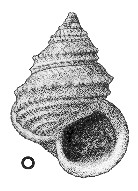
Revised descriptions of New Zealand Cenozoic Mollusca from Beu and Maxwell (1990)

 | Revised descriptions of New Zealand Cenozoic Mollusca from Beu and Maxwell (1990) | 
|
  (Pl. 4o): neck of Tarawhenua Peninsula, Pitt Island, Waipawan (Otago University Geology Department) |
Beu & Maxwell (1990): Chapter 6; p. 94; pl. 4 o.
Synonymy: Bathybembix n. sp., Beu & Maxwell 1990, p. 94, pl. 4 o.
Classification: Chilodontidae (Williams et al. 2008)
Description: Size moderate for family (height 28 mm), turbiniform, spire elevated. Protoconch not known; teleoconch of about 6 whorls, those on spire biangulate, the adapical angulation near middle of whorl, the other somewhat less prominent and close to lower suture. Last whorl with 2 additional, much weaker angulations on base. Spiral sculpture of 2 narrow cords marking keels on spire whorls with another, much weaker one appearing between abapical keel and lower suture on penultimate whorl, emerging on base as the upper basal angulation, accompanied by 2 even weaker cords below. Axial sculpture on early whorls of narrow, strongly prosocline costellae that form small, sharp tubercles at intersections with spiral keels. On later whorls costellae becoming obsolete except for short ridges on upper part of ramp, but tubercles remaining prominent on keels, those on lower keel smaller and more numerous than those above. Basal angulations only feebly nodulose. Aperture circular, prosocline, peristome discontinuous, outer lip reflected to form narrow varix, 1 or 2 varices persisting at earlier stages of growth.
Comparison: This distinctive species was only doubtfully referred to Bathybembix by Beu & Maxwell (1990), as typical members of the genus do not have a reflected outer lip or varix. A reflected outer lip is present in the type species of Turcicula Dall, 1881 but this is distinguished from the Chathams species by having vermiculate background sculpture. Bathybembix itself is a deep- and cool-water genus at the present day (Hickman 1980, p. 16), so its presumed occurrence with distinctly warm-water molluscs in the Red Bluff Tuff would be somewhat anomalous. Hickman & McLean (1990, p. 79) pointed out that Calliovarica Vokes, 1939 is the only tochoidean genus that retains varices on spire whorls, and the New Zealand species seems very similar to the type species of Calliovarica, C. eocensis Vokes, 1939, from the Domengine Eocene of California, USA (Vokes 1939, p. 182, pl. 22, fig. 20, 23, 25, 28), apart from the New Zealand species having a shorter spire.
Distribution: Waipawan (?), Red Bluff Tuff, Tarawhenua Peninsula, Pitt Island (uncommon); Pt Weeding, Chatham Island (uncommon).
Cite this publication as: "A.G. Beu and J.I. Raine (2009). Revised
descriptions of New Zealand Cenozoic Mollusca from Beu and Maxwell (1990). GNS
Science miscellaneous series no. 27."
© GNS Science, 2009
ISBN
978-0-478-19705-1
ISSN 1177-2441
(Included with a PDF facsimile file
copy of New Zealand Geological Survey Paleontological Bulletin 58 in CD version
from: Publications Officer, GNS Science, P.O. Box 30368 Lower Hutt, New
Zealand)